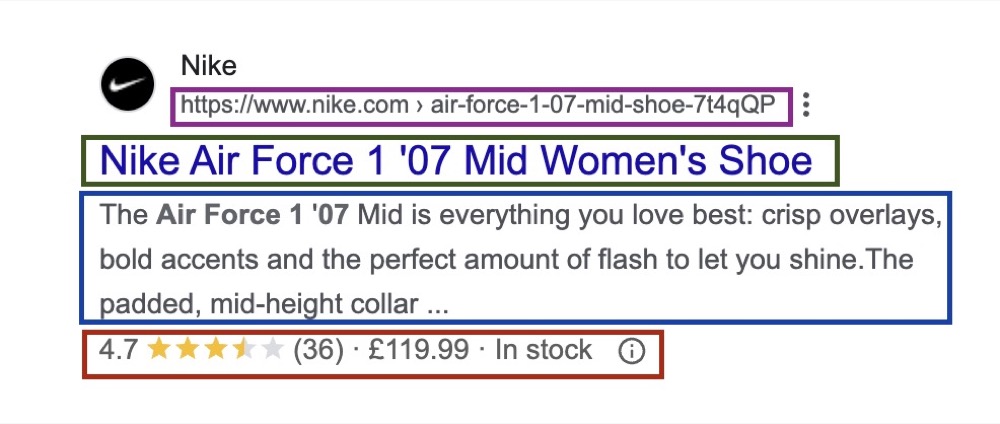Wondering how you can improve how your products appear in search engines like Google? In this article, we’ll break down each part of a search result listing and show you how to optimise them in Shopify’s product page admin.
Understanding product rich results
Rich results are special search listings that show extra information about a webpage right in the search results. They help your products stand out and give users more details before they click on a link. This can include things like images, ratings, prices, and reviews, helping shoppers make better choices. To illustrate, let’s look at a search result example from Nike that includes a Rich Result:

URL (Purple Box)
The search result displays the domain and URL, which helps users understand where the link leads. In this case, it’s the official domain for Nike, enhancing the search result’s trustworthiness. Alternatively, the site name can also be used instead of the domain.
Result Title (Green Box)
Each search result has a title linked to the webpage, derived from the title tag on your page. Keep in mind that Google’s algorithm may rewrite the title to better align with your content or relevant search keywords. Therefore, ensure your title is a clear and accurate descriptor of the content that follows.
Page Description (Blue Box)
Next, you’ll see a short description of the page. This typically ranges from 155-160 characters for desktop and 120 characters for mobile. The description comes from the meta description tag on the webpage, but Google may also rewrite it based on the content it finds. Aim to craft a compelling description that entices users to click through.
Rich Result Data (Red Box)
Finally, there’s the Rich Result section, displaying product details such as average ratings, number of reviews, price, and stock availability. Rich Results enhance search visibility and user engagement but only appear if you have the correct structured data on your webpage.
Why optimising your meta field matters
Almost all search results display the title, URL, and description. Even if you don’t manually configure these fields, Google will automatically generate something based on the content it finds. This is why providing high-quality descriptions is crucial—Google is eager to use what you provide.
While you can’t fully control how Google presents your search results, you can influence it by filling out the meta title and meta description for all pages. In Shopify, you can find these options at the bottom of your product page in the admin panel. Don’t overlook collections, blog posts, and main blog pages; if you don’t set these fields yourself, Google will decide for you, potentially using less-than-ideal descriptions.
How to edit meta fields in Shopify
- Click on the “Edit website SEO” link: This will take you to the options for entering the meta title, meta description, and editing the URL.
- Be cautious with URLs: If you’re changing an existing URL, remember to set up a redirect to avoid broken links.
How to enhance your Rich Results
Rich Results are not common; they represent a search enhancement you must earn through high-quality structured data that describes your page effectively. Unfortunately, many Shopify themes lack the structured data necessary to qualify for these enhancements.
To get rich results, you need to add something called structured data (also known as schema markup) to your product pages. Shopify already includes some of this, but you can make it even better by using apps that add more details.
In the Shopify App Store, there are some options that can help you set up structured data easily like SmartSEO and Schema Plus for SEO. These apps can make the process simpler and help ensure the information you provide is correct.
After adding structured data, use Google’s Rich Results Test tool to see if your product pages can show rich results. This tool will help you find any problems with your structured data and give you tips on how to fix them.
Conclusion
Making your Shopify store’s search results better can help more people find you online and keep them engaged. By paying attention to your meta fields and how search results are set up, you can improve how your products look in search engines.
Regularly check and update your meta titles, descriptions, and structured data to get the most out of your store.





